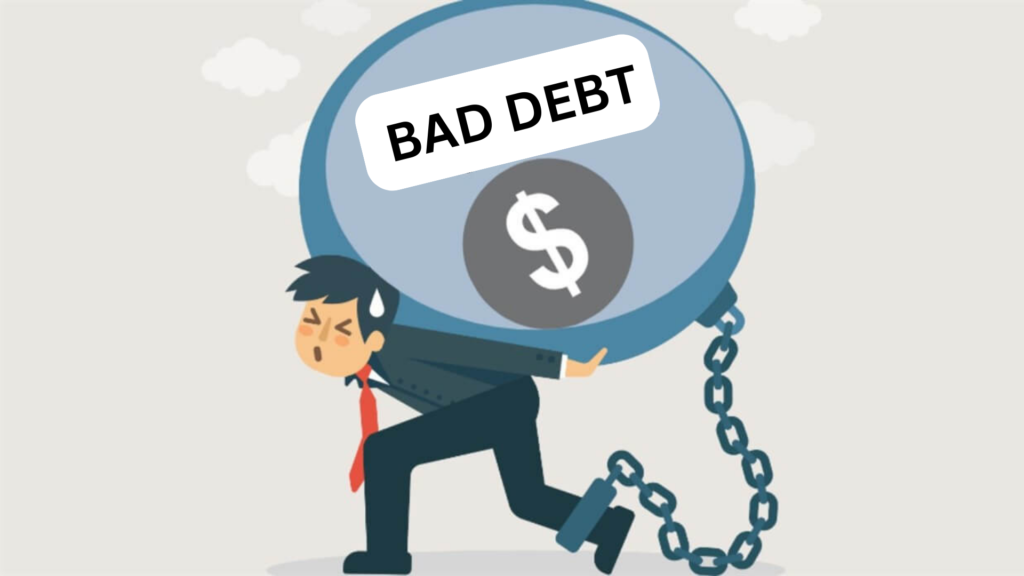What is bad debt? What impact does it have on the loan application process at banks? What causes bad debt, and what should you be aware of to avoid it?
In the following content, Topgovn will answer all related questions about bad debt, including how to check and clear bad debt quickly.
What is Bad Debt?
Bad debt refers to overdue debts that include both principal and interest, which have not been paid by the agreed deadline in the credit contract. If the loan is more than 90 days overdue, it will be classified as bad debt.
According to banks and financial institutions, bad debt is categorized into group 3 (substandard debt), group 4 (doubtful debt), and group 5 (potentially irrecoverable debt). Based on the customer’s repayment ability, the bank will classify the debts into appropriate groups. All information about individuals with bad debt will be updated in the bad debt list on the system of the Vietnam National Credit Information Center (CIC).

How Many Groups of Bad Debt Are There?
Banks and financial institutions classify bad debt into five groups based on the duration of the overdue payment:
- Standard Debt Group: Applies to customers who are late in payment for 1-10 days. This group is considered to have a high likelihood of recovering both principal and interest on time.
- Debt Needing Attention Group: For customers late in payment for 10-30 days. The bank or financial institution will adjust the repayment schedule for the first time.
- Substandard Debt Group: Customers late in payment for 1-3 months. The loan repayment schedule will be restructured for the first time if overdue by less than 30 days. Customers may receive an interest rate reduction or waiver if deemed unable to pay as per the credit contract terms.
- Doubtful Debt Group: Customers late in payment for 181-360 days, with a high probability of not recovering both principal and interest. The repayment schedule will be restructured a second time.
- Potentially Irrecoverable Debt Group: Customers late in payment for over 360 days and have undergone two previous restructurings but are still late by 90 days.
Causes of Bad Debt
Common reasons for bad debt include:
- Customers not repaying loans on time as per the credit contract.
- Forgetting or intentionally delaying payment of charges incurred using credit cards.
- Failing to pay the minimum required amount on credit card bills.
- Intentionally not making payments due to disputes over interest calculations.
- Exceeding the credit card limit without the ability to pay.
- Not paying on time for installment purchases from retail stores.
How to Quickly Check for Bad Debt
To quickly check for bad debt and determine the group you fall into, follow these steps:
- Check Information via CIC System: Bring your ID card to the Vietnam National Credit Information Center at:
- Headquarters: 10 Quang Trung, Ha Dong District, Hanoi, Vietnam.
- HCMC Branch: 1st Floor, 68 Nguyen Hue, District 1, Ho Chi Minh City, Vietnam.
- Pay Off the Debt: Visit the lending institution or bank to clear all debts and keep all payment receipts.
- Recheck Information: After one month, check the CIC system again. If previously in group 2, it takes 12 months to clear bad debt; for groups 3, 4, and 5, it takes 5 years.
Impact of Bad Debt
Bad debt can significantly affect your credit history and the ability to obtain loans from financial institutions. The severity depends on the bad debt group. Some financial companies might still consider group 2 bad debtors, but banks generally do not support loans for such customers. For groups 3, 4, and 5, no financial companies or banks will approve loans, and the bad debt information will be stored at CIC for 3-5 years after full repayment.
How Long is Bad Debt Stored?
Typically, bad debt for loans over 10 million VND is stored on the CIC system for at least five years, while debts under 10 million VND, if settled, will not be stored.
How to Clear Bad Debt?
To clear bad debt, identify which of the two scenarios you fall into:
- Bad Debt Due to Customer’s Late Payment:
- Check the CIC system to determine your bad debt status.
- Visit the financial institution or bank to clear the debt and keep all payment records.
- Recheck the CIC system after one month to see if the bad debt has been cleared. Note that group 2 bad debts are stored for 12 months, while groups 3, 4, and 5 are stored for five years after full repayment.
- Bad Debt Due to Financial Institution/CIC Error:
- Check your bad debt status at CIC.
- Submit a complaint to the financial institution or CIC.
- Directly send the complaint to the bank or CIC for resolution.
- Recheck your bad debt status on the CIC website after receiving the resolution.
Tips to Avoid Bad Debt
Bad debt has serious consequences, so consider the following tips to avoid it:
- Assess your financial situation before borrowing and ensure that loan repayments do not exceed 50% of your income.
- Avoid taking additional loans if you are already in bad debt or have a low credit score.
- Pay attention to credit card payment deadlines and avoid exceeding your repayment capacity.
- Do not borrow money if you are unsure of your ability to repay, as this can lead to bad debt and make future borrowing difficult.
Conclusion
This article provides comprehensive information about bad debt, including its definition, causes, and important tips to avoid it. Hopefully, you now understand what bad debt is and how to avoid it.
